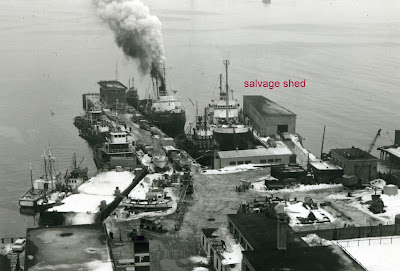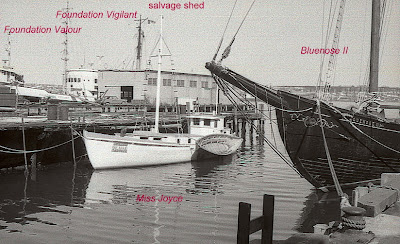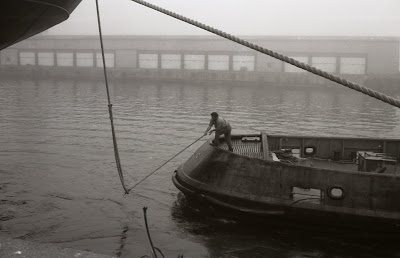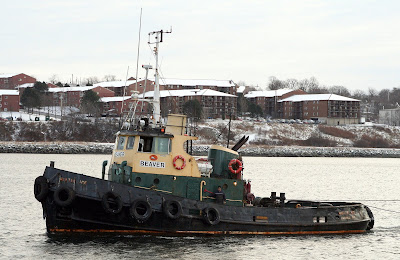This morning the veteran tug Swellmaster and the smaller tug Atlantic Tamarack arrived with an interesting tow, consisting of the dredge D-6 and the scow HD-9. Cradled in the scow was the tug/workboat Irving Chestnut. The convoy originated in Montreal, where the dredge plant worked on and off over the past few years in the St.Lawrence Seaway.
Once in past George's Island, Tamarack moved the scow alongside the dredge and assisted in tying up at pier 7.
 Lining up for the approach to pier 7, Atlantic Tamarack leans into the D-6.
Lining up for the approach to pier 7, Atlantic Tamarack leans into the D-6. Swellmaster is running out of water forward, and has her stern up against D-6 ready to let go the bridle. A puff of smoke from Tamarack's newly installed Cat engine drifts across the dredge.
Swellmaster is running out of water forward, and has her stern up against D-6 ready to let go the bridle. A puff of smoke from Tamarack's newly installed Cat engine drifts across the dredge.Later in the day the D-6 crane lifted Irving Chestnut out of the scow and placed it in the water. [Update: this did not happen, she is still in the scow as of late in the day]
The plant is operated by Harbour Development Ltd, a division of Atlantic Towing within the JD Irving group of companies. See http://www.harbourdev.com/
The plant is operated by Harbour Development Ltd, a division of Atlantic Towing within the JD Irving group of companies. See http://www.harbourdev.com/
For more on the dredge D-6 see Shipfax.
Soon after these evolutions, the tug Whitby moved three scows from pier 9 to pier 9 C to free the berth for a tanker tomorrow. The scow Harold M was the last to be moved. It can be used for dredging or piling when a small crane is mounted.
 Whitby rounds the knuckle with Harold M on a bridle. When it was secured to the (as yet unknown) scow on the right, Whitby returned to pier 42 to tend to dredging operations there, with Beaver Delta II and the dredge Canadian Argosy.
Whitby rounds the knuckle with Harold M on a bridle. When it was secured to the (as yet unknown) scow on the right, Whitby returned to pier 42 to tend to dredging operations there, with Beaver Delta II and the dredge Canadian Argosy. .
























